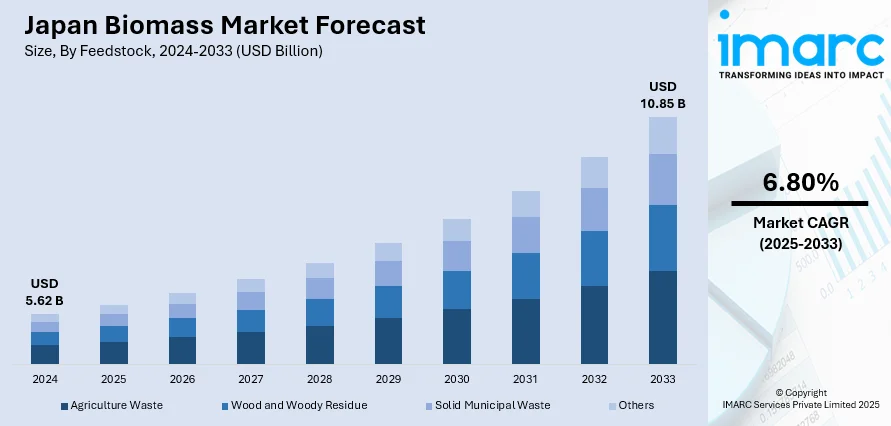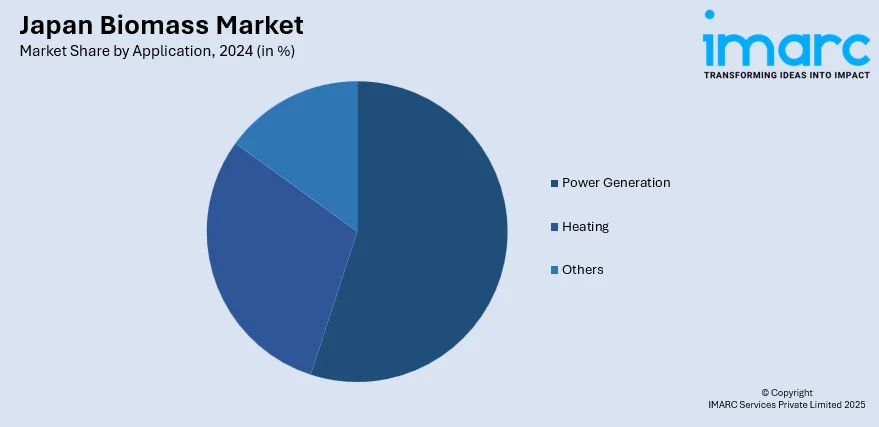
Japan Biomass Market Size, Share, Trends and Forecast by Feedstock, Application, and Region, 2025-2033
Japan Biomass Market Overview:
The Japan biomass market size reached USD 5.62 Billion in 2024. Looking forward, IMARC Group expects the market to reach USD 10.85 Billion by 2033, exhibiting a growth rate (CAGR) of 6.80% during 2025-2033. At present, the increasing number of biomass facilities is promoting investments in biomass supply chains, encompassing harvesting, transportation, and processing infrastructure. Besides this, the presence of abundant forestry resources, which aids in providing a reliable and renewable supply of raw materials for energy production, is contributing to the expansion of the Japan biomass market share.
|
Report Attribute
|
Key Statistics
|
|---|---|
|
Base Year
|
2024 |
|
Forecast Years
|
2025-2033
|
|
Historical Years
|
2019-2024
|
| Market Size in 2024 | USD 5.62 Billion |
| Market Forecast in 2033 | USD 10.85 Billion |
| Market Growth Rate 2025-2033 | 6.80% |
Japan Biomass Market Trends:
Expansion of biomass plants
The expansion of biomass plants is fueling the market growth. As biomass power plants are being built and existing ones are upgraded, the demand for biomass fuel, such as wood pellets, agricultural residues, and waste materials, is rising steadily. The data released from Global Energy Monitor’s Global Bioenergy Power Tracker (GBPT) in September 2024 indicated that Japan is set to have 3.8 gigawatts (GW) of woody biomass capacity spread across 59 units by 2026. Biomass plants aid in contributing to Japan’s energy mix by offering a stable and dispatchable source of electricity, which supports grid reliability. The growing number of biomass facilities is encouraging investments in biomass supply chains, including harvesting, transportation, and processing infrastructure. This broadening is also creating local employment opportunities and promoting the use of domestic resources, especially in rural areas. The development of new biomass plants aligns with national policies targeted at lowering greenhouse gas emissions and enhancing the contribution of renewables in the energy industry. By utilizing low-carbon renewable inputs, these plants are supporting Japan’s environmental and energy security goals. In addition, the expansion of biomass plants helps minimize the amount of organic waste sent to landfills, making the system more sustainable.

Presence of abundant forestry resources
The presence of abundant forestry resources is impelling the Japan biomass market growth. Japan has extensive forested areas, and a significant portion of these forests remains underutilized. As per industry reports, forests accounted for 67% of Japan’s land space, as of November 2024. The availability of wood residues, forest thinnings, sawdust, and other biomass materials is supporting the development of local biomass energy projects. These resources are collected and processed into pellets, chips, and other fuel forms, which are then used for heating, electricity generation, and combined heat and power systems. The local sourcing of biomass reduces dependency on imported fuels and enhances energy security. It also encourages forest maintenance, which helps prevent overgrowth and reduces the risk of wildfires. Rural communities are benefiting through job creation and income opportunities in forestry, transportation, and biomass processing. The employment of forestry resources for energy aligns with Japan’s environmental goals by minimizing greenhouse gas emissions and promoting sustainable land use. Biomass systems facilitated by abundant forestry also enable decentralized energy generation, which is valuable for remote and off-grid regions.
Japan Biomass Market Segmentation:
IMARC Group provides an analysis of the key trends in each segment of the market, along with forecasts at the country and regional levels for 2025-2033. Our report has categorized the market based on feedstock and application.
Feedstock Insights:
- Agriculture Waste
- Wood and Woody Residue
- Solid Municipal Waste
- Others
The report has provided a detailed breakup and analysis of the market based on the feedstock. This includes agriculture waste, wood and woody residue, solid municipal waste, and others.
Application Insights:

- Power Generation
- Heating
- Others
A detailed breakup and analysis of the market based on the application have also been provided in the report. This includes power generation, heating, and others.
Regional Insights:
- Kanto Region
- Kansai/Kinki Region
- Central/ Chubu Region
- Kyushu-Okinawa Region
- Tohoku Region
- Chugoku Region
- Hokkaido Region
- Shikoku Region
The report has also provided a comprehensive analysis of all the major regional markets, which include Kanto Region, Kansai/Kinki Region, Central/Chubu Region, Kyushu-Okinawa Region, Tohoku Region, Chugoku Region, Hokkaido Region, and Shikoku Region.
Competitive Landscape:
The market research report has also provided a comprehensive analysis of the competitive landscape. Competitive analysis such as market structure, key player positioning, top winning strategies, competitive dashboard, and company evaluation quadrant has been covered in the report. Also, detailed profiles of all major companies have been provided.
Japan Biomass Market News:
- In November 2024, Marubeni Corporation finalized the construction of the Aichi Tahara Biomass Power Plant, located in Tahara Cit, Japan, and announced the commencement of commercial operations. The Power Plant was a biomass facility that operated on wood, featuring a generation capacity of 74,950 kW, and was anticipated to produce around 530 Million kWh of electricity annually.
- In February 2024, Seiko Epson Corporation revealed its intention to build the company's inaugural biomass power plant in Iida City, located in Nagano Prefecture, Japan. The new power facility aimed to supply Epson with consistently self-produced renewable energy and lower the proportion of electricity the firm acquired from external suppliers, thus encouraging broader public acceptance of renewable energy sources.
Japan Biomass Market Report Coverage:
| Report Features | Details |
|---|---|
| Base Year of the Analysis | 2024 |
| Historical Period | 2019-2024 |
| Forecast Period | 2025-2033 |
| Units | Billion USD |
| Scope of the Report |
Exploration of Historical Trends and Market Outlook, Industry Catalysts and Challenges, Segment-Wise Historical and Future Market Assessment:
|
| Feedstocks Covered | Agriculture Waste, Wood and Woody Residue, Solid Municipal Waste, Others |
| Applications Covered | Power Generation, Heating, Others |
| Regions Covered | Kanto Region, Kansai/Kinki Region, Central/Chubu Region, Kyushu-Okinawa Region, Tohoku Region, Chugoku Region, Hokkaido Region, Shikoku Region |
| Customization Scope | 10% Free Customization |
| Post-Sale Analyst Support | 10-12 Weeks |
| Delivery Format | PDF and Excel through Email (We can also provide the editable version of the report in PPT/Word format on special request) |
Key Questions Answered in This Report:
- How has the Japan biomass market performed so far and how will it perform in the coming years?
- What is the breakup of the Japan biomass market on the basis of feedstock?
- What is the breakup of the Japan biomass market on the basis of application?
- What is the breakup of the Japan biomass market on the basis of region?
- What are the various stages in the value chain of the Japan biomass market?
- What are the key driving factors and challenges in the Japan biomass market?
- What is the structure of the Japan biomass market and who are the key players?
- What is the degree of competition in the Japan biomass market?
Key Benefits for Stakeholders:
- IMARC’s industry report offers a comprehensive quantitative analysis of various market segments, historical and current market trends, market forecasts, and dynamics of the Japan biomass market from 2019-2033.
- The research report provides the latest information on the market drivers, challenges, and opportunities in the Japan biomass market.
- Porter's five forces analysis assist stakeholders in assessing the impact of new entrants, competitive rivalry, supplier power, buyer power, and the threat of substitution. It helps stakeholders to analyze the level of competition within the Japan biomass industry and its attractiveness.
- Competitive landscape allows stakeholders to understand their competitive environment and provides an insight into the current positions of key players in the market.
Need more help?
- Speak to our experienced analysts for insights on the current market scenarios.
- Include additional segments and countries to customize the report as per your requirement.
- Gain an unparalleled competitive advantage in your domain by understanding how to utilize the report and positively impacting your operations and revenue.
- For further assistance, please connect with our analysts.
 Request Customization
Request Customization
 Speak to an Analyst
Speak to an Analyst
 Request Brochure
Request Brochure
 Inquire Before Buying
Inquire Before Buying




.webp)




.webp)












